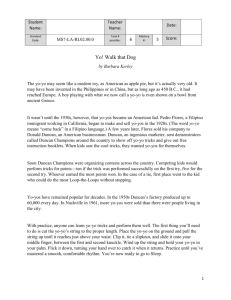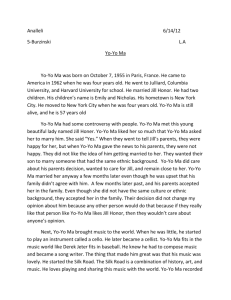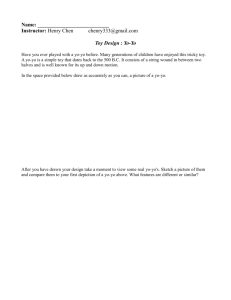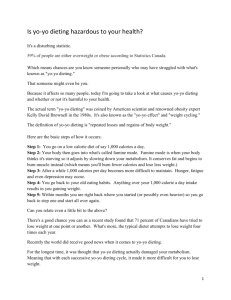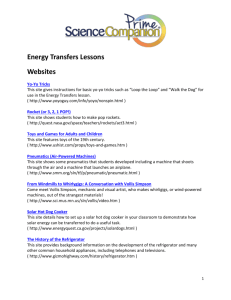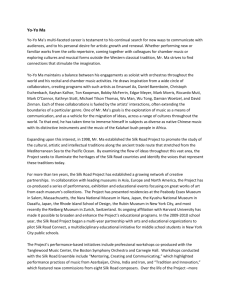Guide to Yo-Yo
advertisement
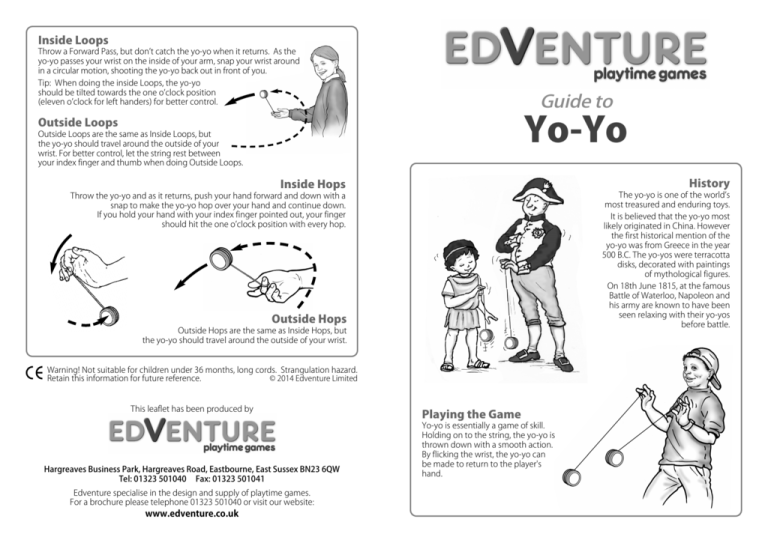
Inside Loops Throw a Forward Pass, but don’t catch the yo-yo when it returns. As the yo-yo passes your wrist on the inside of your arm, snap your wrist around in a circular motion, shooting the yo-yo back out in front of you. Tip: When doing the inside Loops, the yo-yo should be tilted towards the one o’clock position (eleven o’clock for left handers) for better control. Guide to Yo-Yo Outside Loops Outside Loops are the same as Inside Loops, but the yo-yo should travel around the outside of your wrist. For better control, let the string rest between your index finger and thumb when doing Outside Loops. Inside Hops History Throw the yo-yo and as it returns, push your hand forward and down with a snap to make the yo-yo hop over your hand and continue down. If you hold your hand with your index finger pointed out, your finger should hit the one o’clock position with every hop. The yo-yo is one of the world’s most treasured and enduring toys. It is believed that the yo-yo most likely originated in China. However the first historical mention of the yo-yo was from Greece in the year 500 B.C. The yo-yos were terracotta disks, decorated with paintings of mythological figures. On 18th June 1815, at the famous Battle of Waterloo, Napoleon and his army are known to have been seen relaxing with their yo-yos before battle. Outside Hops Outside Hops are the same as Inside Hops, but the yo-yo should travel around the outside of your wrist. Warning! Not suitable for children under 36 months, long cords. Strangulation hazard. © 2014 Edventure Limited Retain this information for future reference. This leaflet has been produced by Hargreaves Business Park, Hargreaves Road, Eastbourne, East Sussex BN23 6QW Tel: 01323 501040 Fax: 01323 501041 Edventure specialise in the design and supply of playtime games. For a brochure please telephone 01323 501040 or visit our website: www.edventure.co.uk Playing the Game Yo-yo is essentially a game of skill. Holding on to the string, the yo-yo is thrown down with a smooth action. By flicking the wrist, the yo-yo can be made to return to the player's hand. Getting started (Teacher note) To throw Before using, we advise that you adjust the string to the correct length for the children using the yo-yo. Have an average sized child hold the yo-yo and let it hang to the floor. With the string held near their body, measure it to about an inch above waist height. Tie a new loop and cut off the excess string. Make a muscle with your yo-yo arm. Throw the yo-yo, while leaving your palm facing up. Turn your palm over to catch. Throw hard and be sure not to twist your palm over until after you release the yo-yo. If you throw the yo-yo at sufficient pace and stop your arm before the yo-yo reaches the bottom of the string, you will have a ‘sleeper’ (spin at the bottom) ‒ the basis of most advanced tricks. Make a slip knot for your finger Rather than just using the loop on the end of the string, a better way is to pull the string through the loop to make a slip knot. Place on middle finger, between first and second knuckle and pull tight. Winding the yo-yo Place a finger over the string groove in the middle of the yo-yo, wind over the finger the first time around, then under the finger the rest of the way up. Hold the yo-yo in your hand, palm up, with the string wrapped so it comes off your middle finger and goes over the top of the yo-yo as shown. Adjusting the yo-yo If the yo-yo will not ‘sleep’ or the string bunches on the yo-yo, take the string off your finger and let it hang down to untwist. Right-handers tend to make the string too tight; left-handers tend to make the string too loose. You are likely to have to untwist the string frequently. TRICKS AND VARIATIONS Forward Pass Hold the yo-yo with your arm hanging by your side, with the back of your hand facing forward. Swing your arm forward, as you drop the yo-yo. Turn your hand palm up, and tug to make it return. See how many times you can do it in a row without stopping. Tip: If the yo-yo spins at the end of the string, just give it a little tug and it will come back up.



